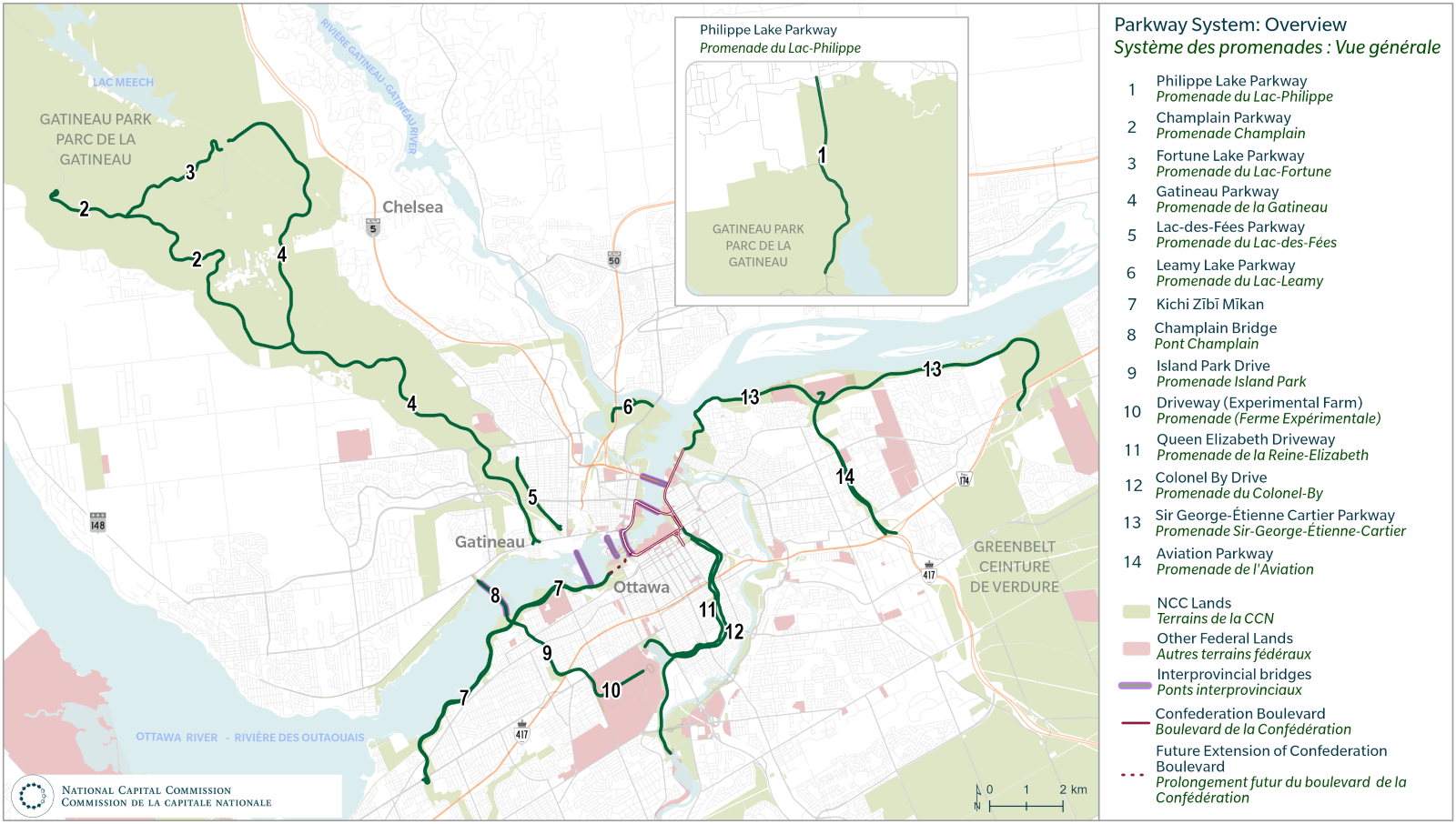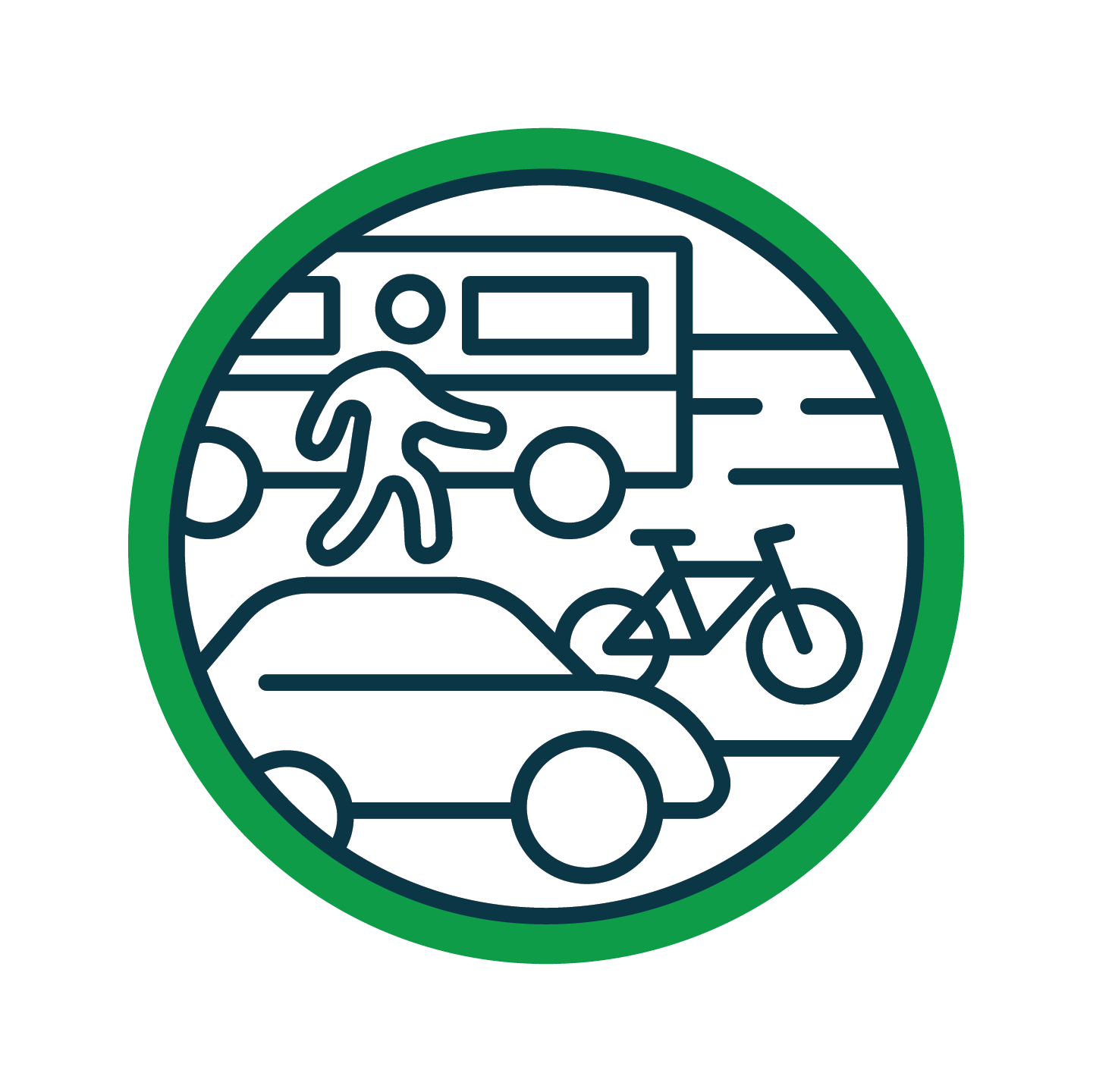The NCC is creating new planning and design guidelines to guide future decisions and better protect and enhance the parkways of the National Capital Region.
The guidelines aim to provide a new vision, guiding principles and supporting policies for the parkway corridors, while acknowledging their heritage and legacy. The new guidelines will adapt to the different contexts and functions of each parkway and be better aligned with recent NCC plans and contemporary planning practices.
About the parkways
The NCC and its predecessors have been planning and managing parkways in the National Capital Region since the early 20th century. These scenic parkways are recognized as part of the Capital’s valued cultural landscapes, providing gateways to the Capital and linking important landmarks like Parliament Hill and national museums and institutions.
Today, the network spans over 90 km, featuring and connecting waterfronts, parks and green spaces.

NCC parkways are distinct from municipal, regional and provincial roads. They have been planned in harmony with their surrounding corridors, and include viewpoints, heritage, cultural, ecological and environmental features. Many NCC parkways are also complemented by adjacent NCC multi-use pathways for users to experience and enjoy.
Draft vision
We propose the following vision for the Parkway Planning and Design Guidelines:
“Canada’s Capital parkways offer scenic passages across diverse cultural, natural and urban landscapes that connect major Capital attractions. These experience-rich corridors are designed in accordance with their surroundings, promote healthy lifestyles, provide equitable access to parks and waterfronts, and contribute to a resilient and sustainable National Capital Region.”
Guiding principles
In support of the proposed vision, we are considering six guiding principles for the planning, design and stewardship of the parkway network in the coming decades. We are also developing policies, guidelines and planning directions for the entire network and for each parkway in coherence with the vision and principles.

Distinct Experiences, Views and Landscapes
Parkways are an emblematic feature of the National Capital Region that contribute to its unique picturesque and natural qualities and provides distinct experiences to residents and visitors. They impress the beauty of their surrounding green spaces, and the diversity of cultural, urban and natural landscapes, while offering views of the Capital’s scenic landmarks.
- Enhance the Capital experience
- Preserve, restore and enhance natural and cultural landscapes
- Create a sense of Capital place and provide opportunities to learn about heritage and history
- Seek appropriate federal heritage designation for certain corridors

Sustainable Mobility and Active Use
Parkway design, policies and stewardship are focused on achieving federal, provincial and regional sustainable transportation targets by prioritizing walking, cycling and other forms of sustainable mobility. They also offer flexibility and opportunity for recreation and sporting activities to promote healthy and active lifestyles in the National Capital Region.
- Enhance equitable access and experience of sustainable mobility users
- Accommodate transit, shuttles and other transportation services, under specific terms and conditions
- Implement periodic or seasonal closures of vehicular traffic to accommodate events and seasonal recreational activities, to promote active transportation and/or to protect wildlife
- Ensure parkways are distinct from the local transportation network
- Plan for facilities offering more space, comfort and safety for active users along the roadway.
- Prohibit certain types of vehicles on parkways, unless authorized under agreement
- Prohibit the creation of new driveway accesses, except is special cases
- Revise vehicular connections and implement additional measures to reduce vehicular traffic

Safe, Equitable and Inclusive
Parkways offer safe, inviting, welcoming, equitable and inclusive access to all, irrespective of gender, age, ability and origin.
- Plan and design parkways to exceed all applicable federal, provincial and municipal universal accessibility guidelines and standards
- Implement design and traffic calming strategies to support low vehicular speeds
- Collaborate with partners to provide equitable and inclusive access
- Plan projects in the parkway corridors using a universal accessibility design lens

Ecosystem Preservation, Rehabilitation and Urban Resiliency
Parkway corridors are a vital source of urban resiliency and form part of the Capital green space network that must be enhanced and protected.
- Protect historic and remarkable trees, habitats and vegetation, and support the stewardship and ecological values in keeping with Indigenous traditions
- Ensure the right balance between the tree canopy and the protection and enhancement of view sheds
- Counter impacts of climate change, strengthen biodiversity and improve comfort and resiliency
- Create opportunities to understand and learn about the region’s natural heritage

Connections to Surroundings and Placemaking
Parkway corridors are designed cultural landscapes, intentionally connected to their surroundings through context-specific design and planning, while offering meaningful placemaking in harmony with their urban, waterfront or natural context.
- Consider local character and surroundings when making decisions
- Explore opportunities to reimagine, transform and improve cultural landscapes along urban corridors, without compromising their valued natural and cultural integrity
- Collaborate with Indigenous groups to strengthen their cultural traditions through placemaking and partnerships
- Improve or reestablish active mode connectivity and permeability in collaboration with partners
- Develop and refine tools with partners, allowing for the review of development proposals
- Improve visitor attractions and amenities and provide locations for natural and cultural interpretation

Sustainable Stewardship
The Capital parkways and their corridors are planned, designed, owned, managed and maintained by the NCC in a durable, prudent and financially sustainable manner. They are planned and designed in a collaborative, multi-disciplinary manner that involves a wide range of subject matter experts to ensure design excellence.
- Continue with federal ownership and management of the parkway network
- Involve a wide range of experts in planning and design
- Take the use of the lands and rivers by Indigenous peoples into consideration
- Collaborate to improve the user experience, design and coherence of scenic entries and Capital arrivals
- Monitor the vocational performance of parkway corridors to ensure safety, user experience and balance of users
- Ensure high standards of maintenance
Engagement
Your input is crucial for creating the new Parkway Planning and Design Guidelines and understanding the community’s needs, challenges and vision for the parkways.
Public consultation will happen in two phases.
- Phase 1: Gather feedback on the values, challenges, vision, guiding principles and supporting policies for NCC parkways - Fall 2024
- Phase 2: Gather feedback on the 90% draft of the guidelines - Spring 2025
Process and timeline
Fall-Winter 2023 (completed)
- Review current guidelines and conditions
Winter-Spring 2024 (completed)
- Engage with agency stakeholders
Summer-Fall 2024 (completed)
- Engage with community stakeholders
- Engage with the public (first phase)
- Develop parkway-specific strategies, design guidelines and supporting policies
Winter-Summer 2025 (In process)
- Draft Parkway Planning and Design Guidelines
Fall-Winter 2025
- Engage with the public and stakeholders (second phase)
- Finalize the updated guidelines
- Submit updated guidelines to NCC Board of Directors for approval
Documents
- The Plan for Canada's Capital, 2017–2067 (51.315 MB)
- Policy for Parkways and Driveways (1984) (2.692 MB)